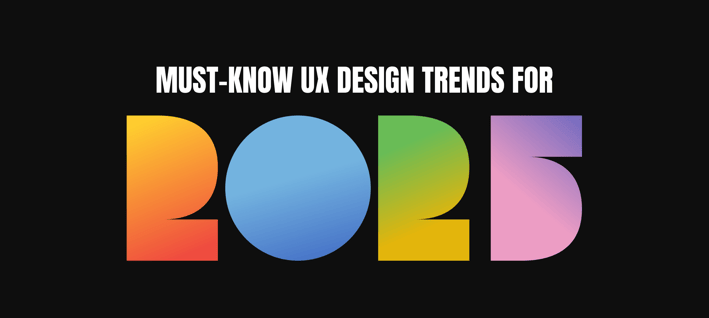Top 7 UX Design Trends to Watch in 2025
User experience design is evolving rapidly, and 2025 is set to raise the bar even higher. As artificial intelligence, personalization, and user expectations continue to grow, designers must stay ahead of the curve. In this article, we explore seven emerging UX design trends for 2025 that will help businesses deliver smarter, more engaging, and more intuitive digital experiences.
Truly Design Firm
1/21/20254 min read


Top 7 UX Design Trends to Watch in 2025
User experience design is evolving rapidly, and 2025 is set to raise the bar even higher. As artificial intelligence, personalization, and user expectations continue to grow, designers must stay ahead of the curve.
In this article, we explore seven emerging UX design trends for 2025 that will help businesses deliver smarter, more engaging, and more intuitive digital experiences.
1. Proactive User Experience (PX)
Proactive UX, or PX, is a design approach that anticipates user needs before they are expressed. Instead of waiting for input, systems use AI and behavior analytics to offer suggestions, content, or functionality that users are likely to want next.
Why It Matters in 2025:
With advancements in AI and machine learning, PX will become more personalized, timely, and accurate—providing seamless interactions that improve user satisfaction and retention.
Tips for Designers:
Use behavioral data and AI to predict user actions
Make AI-generated suggestions transparent to users
Add disclaimers or corrections for inaccurate predictions
Example:
Spotify could analyze listening trends to predict and suggest potential hit tracks before they're officially released.
2. Interactive Animations
Animations have long enhanced UX, but 2025 will see a rise in interactive animations—ones that respond to user actions in real time. This adds a new layer of engagement and functionality.
Key Benefits:
Enhances user control and satisfaction
Improves storytelling and visual feedback
Boosts retention through gamified interactions
Examples:
Duolingo’s responsive animated characters
Figma’s smooth scroll-based animations
Apps using Lottie or Rive for interactive motion design
Pages that use animation effectively can experience up to 40% higher engagement compared to static designs.
3. Bento Box Design
The Bento Box layout organizes content into clean, modular sections. It was popularized in 2023 and continues to dominate in 2025 due to its versatility and user-friendly design.
Why It Works:
Improves readability and information flow
Ideal for dashboards, portfolios, and editorial platforms
Helps users scan and find relevant content quickly
Notable Use Cases:
Pinterest’s grid layout for visual browsing
The Wall Street Journal’s modular article blocks for improved readability
4. Voice, Gesture, and Invisible Interfaces
As users interact with digital products in more dynamic environments, interfaces that go beyond the screen are becoming essential. Voice assistants, gesture recognition, and AI chatbots are shaping the way we design for the future.
Opportunities for UX Designers:
Design for hands-free and screenless interactions
Build voice-enabled, context-aware user journeys
Enhance chatbot interfaces with more conversational and intelligent flows
Emerging Example:
AI tools like ChatGPT are now used in help centers and product onboarding to create natural, intuitive conversations with users.
5. Neumorphism
Neumorphism blends minimalism with realism, using soft shadows and gradients to simulate physical surfaces. While it’s not new, the trend is evolving in 2025, offering a subtle way to bring depth and tactility to digital interfaces.
Why It Remains Relevant:
Provides a fresh visual style without overwhelming users
Works well in clean, minimalist UI environments
Best Practices:
Use sparingly to maintain accessibility
Apply to specific components like cards, toggles, or call-to-action buttons
6. Customizable Self-Expression
Today’s users expect apps to reflect their personal identity. In 2025, customization is no longer a bonus—it’s a requirement. From themes to layouts, users want to control how they experience digital products.
Implementation Tips:
Allow changes to color themes, fonts, and layouts
Let users control content structure and delivery formats
Examples:
Slack lets users personalize UI themes
Fold Money App allows dashboard widget reordering
Grapevine offers content format selection for news delivery
Customization enhances emotional connection, loyalty, and user satisfaction.
7. Animated Typography
Animated typography adds energy, emotion, and hierarchy to textual elements. Whether it's for marketing pages or interactive apps, moving text is increasingly used to grab attention and communicate key messages.
Use Cases:
Website hero sections
App loading screens
Section transitions and scroll-triggered headlines
When done right, animated text can elevate content, improve storytelling, and make interfaces more memorable.
Conclusion
The future of UX design is smart, interactive, and personalized. Trends like proactive UX, interactive animations, and customizable interfaces will define how digital products engage users in 2025 and beyond.
Designers who embrace these changes will not only create beautiful experiences—but meaningful, functional, and scalable ones.
FAQs
What is Proactive User Experience (PX)?
PX involves using data and AI to predict what users want next—offering a more seamless and intuitive experience.
How do interactive animations impact engagement?
They respond to user input in real-time, significantly boosting interactivity, retention, and satisfaction.
Why is Bento Box design trending?
It helps structure complex content into easy-to-navigate sections—ideal for dashboards and editorial layouts.
How does customization benefit UX?
It increases user engagement by allowing people to tailor experiences to their personal preferences.
Why use animated typography?
It enhances visual hierarchy, emotion, and storytelling in digital content.
Quick Links
Design Services
Contact us
Branding and Identity
Enterprise UX, UI
Mobile App UX Design
Website UX,UI
B-Block, BHIVE Workspace -No. 112,
AKR Tech Park, 7th Mile Hosur Rd, Bengaluru, Karnataka 560068
Truly Design Firm is a creative powerhouse specializing in branding, UI/UX, product design, mobile app, and website design. We’re dedicated to delivering impactful designs that help businesses stand out and succeed. With a focus on quality, innovation, and long-term client relationships, we craft solutions that inspire and drive results.
Follow Us
Copyright ©2025 Truly Design Firm
